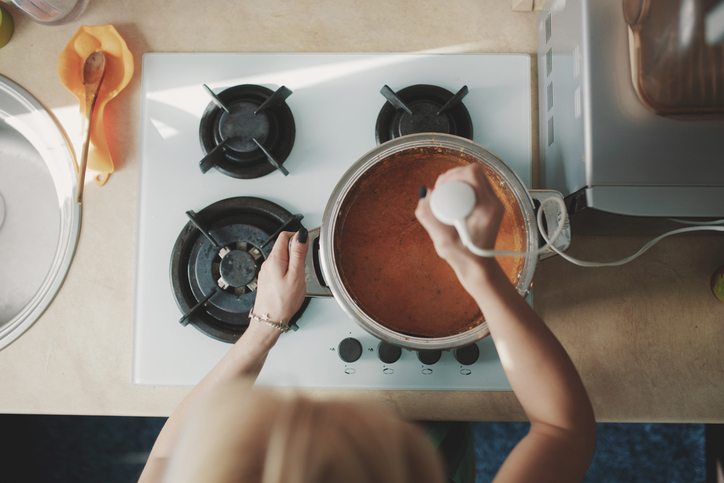February 28 is Rare Disease Day. Healthista’s Vanessa’s Chalmers hears how a dodgy Chinese left one lady with a stomach paralysed and on liquid food for life
For many of us, food and social lives go hand in hand. Historically we gather at the table to eat for celebration, satisfaction and fulfilment. Our day to day lives must incorporate when we are going to stop to eat, or even revolve around food entirely.
It’s a different situation for Georgia Sands*, a 53 year old woman from Surrey, who doesn’t have a stomach. With no hunger pangs, weight loss of over four stone over the last six years and a low shopping list budget, food is the last thing on her mind. It’s easy to assume what a relief that must be, what a blessing to never feel hungry or consume too many calories. Instead, it is nothing but a frustrating burden. Georgia vomits around three-four times a day, is on constant morphine, can’t eat solids and is having Botox to relieve pain from migraines.
Having no stomach means Georgia vomits around three-four times a day, is on constant morphine and can’t eat solids
How it started
It all began one evening at the end of a holiday to Corfu 15 years ago. It had been a relaxing get away for Georgia and her three friends, but ended with a stomach bug. A dodgy Chinese meal and a little too much to drink, Georgia spent her last day in the hotel bathroom vomiting, but relieved to be flying home in a few hours. Once home, the bug continued to haunt her, coming back every three weeks or so and debilitating her of eating and going about her daily business.
‘I couldn’t keep anything down’, Georgia recalls. ‘I just thought it was one of those things, and I didn’t let myself worry too much about it. Eventually I went to my GP about it and he guessed it was a sickness bug too, and no investigations were done. This continued for three years, a repetitive pattern of becoming ill and consistently vomiting.’
For Georgia, life continued this way until a dramatic turn brought her illness to doctor’s attention. ‘It really kicked off in 2005. I had already been in and out of hospital throughout 2014, one period being 14 weeks. They couldn’t find out why, and to say it was beginning to concern me is an understatement’, says Georgia.
I was told my stomach was literally paralysed
‘In 2005, I collapsed at Waterloo station. The ambulance took me to St Thomas’ Hospital, and I remember feeling terrified at the back of the ambulance. It was then, after five weeks in hospital, that they found out what was wrong’. Georgia was told she had a form of gastroparesis, a long-term chronic condition whereby the stomach struggles to empty.
Georgia was told she had a form of gastroparesis, a long-term chronic condition whereby the stomach struggles to empty.
For normal people, the stomach can empty in one and a half to two hours, but with gastroparesis, the nerves of the stomach are damaged, and the delay of emptying can result in bothersome effects. Nausea, vomiting, regurgitation and a feeling of fullness after a few bites are common. ‘I was told my stomach was literally paralysed’, says Georgia. ‘When I ate, food would sit in my stomach for hours, not able to be digested, until eventually the only way out was to come back up.’
MORE: How breast cancer saved me from workaholism
What causes gastroparesis?
In many cases of gastroparesis, there’s no obvious cause, according to the NHS. This is known as idiopathic gastroparesis. Some known causes include poorly controlled diabetes, complications with surgery, such as removal of part of the stomach (gastrectomy), medication, such as opioid painkillers like morphine or antidepressants, or Parkinson’s disease. It can also be onset by rare diseases scleroderma and amyloidosis. None of these diseases were present in Georgia’s life, only a cardiac condition, Aortic stenosis, which she had since birth and had a pacemaker for.
Treatment of gastroparesis
When Georgia was first diagnosed with gastroparesis, she was given the typical treatment suggestions. This normally involves dietary and lifestyle measures, which include eating five to six small meals each day, instead of three, and avoiding high-insoluble fiber and high-fat foods, both of which can slow down stomach emptying. Lactose intolerance is also common in gastroparesis, so dairy is often avoided. Medication is used to stimulate stomach emptying (motility agents) and reduce the nausea (antiemetics), which can be the biggest challenge to control.
For Georgia it was a different story, as her condition deteriorated.
‘I thought the doctors would figure out how to fix it, and that the worst case scenario, I would throw up every now and again. But the throwing up became more frequent and I was losing weight’, recalls Georgia. Her case became severe, and she was moved onto a more serious treatment – jejunostomy (feeding tube). ‘In 2009 they put a feeding tube in me so that I could get the basic nutrition. Liquid food was put through a tube which was inserted through my abdominal wall directly into the small intestine, bypassing the stomach. I had to put myself up to a feed at night, and then unhook it in the morning, only allowing myself liquid during the day.
When I had a tube in my nose, people would move to the other side of the bus
‘Sometimes the opening where the tube is inserted would become infected, and the smell was horrendous. It was so bad you couldn’t cover it. I’d get funny looks from people and I just used to turn round and look at other people as if it wasn’t me. I’d get a temporary nasojejunal tube, where it was inserted in my nose, and when I would sit on the bus, people would move to the other side of the bus.’
Removal of the stomach
By 2011, Georgia’s case had moved onto what the National Organization for Rare Disorders (NORD) categorize as Grade 3 – gastric failure. She wasn’t responding to typical medications, wasn’t maintaining nutrition or hydration, and was requiring hospitalization. The next stage, surgical intervention, is rare.
Surgical intervention to remove Georgia’s stomach
‘They took my stomach out in 2011 after three and a half years of having the tube’, Georgia says. ‘My stomach wasn’t healing itself. It was refusing to co-operate with me. They thought the best option was to take it out, hoping I would be able to eat normally after that. I was worried they were covering up that I had cancer, because they were suggesting such drastic measures.
I could possibly eat again
‘I thought this could be an improvement. No, I wouldn’t be able to eat like I once could, but it may solve my problems to the extent that I could eat again. Avoid steak, potato skins, any hard food, the doctors said, but everything else I could possibly eat again.’
MORE: 5 foods that prevent heart disease
Georgia went through a total gastrectomy, as elimination of the stomach through near total gastrectomy shows little improvement in symptoms, according to NORD. Experts agree that the entire stomach is affected in severe gastroparesis; therefore, treatment by total gastrectomy is used as a palliative measure. However, the major surgical procedurecarries risks, including a significant 3.5 per cent risk of death, and no option to take advantage of any new pharmacological therapies that may come along. Nausea and vomiting also remain a very troubling symptom, which Georgia was soon to find out.
Life without a stomach
‘I had high hopes for my recovery after the gastrectomy, but I’ve been in and out of hospital since, downhill from the moment I left. The worst part of this journey was when I was in hospital in 2015, and during this time my dad passed away, who I was very close with and a carer for towards the end of his life. I was unable to say goodbye, being bed ridden myself, and that was a point where no amount of positivity could improve what had happened.
It doesn’t sound great, but I can eat anything sloppy or liquidised.
‘I am extremely grateful I can eat a small amount of food, and I have had some weight gain. It doesn’t sound great, but I can eat anything sloppy or liquidised. Jelly, mashed banana, porridge or scrambled eggs; it’s not exactly an exciting meal, but I try not to view it like that. I have to add powders to all my food for calories and protein, which is the only real source of nutrients I get. I must be absorbing them, otherwise I wouldn’t be here.

‘Unfortunately I still vomit three times a day or more, and I sometimes wonder what the point of eating is. I’m never hungry, and when it comes back up the effort of eating it seems a waste of time. Not to mention that the repetitive vomiting has onset more side effects, such as hernias. When these are repaired, in their place is a mesh, a sort of gauze to keep everything in place. The more mesh they put in, the more difficult it will be for procedures in the future. I always have a morphine patch, because of the severe abdominal pain where my stomach once was, which, is now a large amount of scar tissue’.
I vomit three times a day or more, and I sometimes wonder what the point of eating is
‘The strangest part of my medication is Botox around my hairline’, says Georgia. ‘But that is for the constant migraines I get. They didn’t believe it would help my stomach problems’. Although Georgia’s Botox is for migraines, it is also a treatment for gastroparesis itself. It can be used to control the spasms of the pyloric sphincter, or pylorus, a ring of muscles that helps to control the passage of food from the stomach into the small intestine. ‘When Botox (botulinum toxin) is injected into the pyloric muscles, the sphincter should relax and allow more food to pass through’, according to Gastroparesis Clinic. ‘The trials of this treatment approach have had varying results, with some patients demonstrating a decrease in symptoms for 1-6 months, but controlled trials (the highest level of evidence) not showing significant effects. This treatment is usually only recommended if other approaches have not been successful, and further studies are being conducted on the temporary improvements that Botox may have on gastric emptying’.
MORE: How breast cancer saved me from workaholism

The Gastroparesis Clinic in the US explains that the cause of abdominal pain in gastroparesis is not well understood, and medications for pain can often counteract the beneficial effects, and may even make the symptoms worse. ‘Some patients may require strong medications for severe pain. Unfortunately, opiates [such as morphine] can slow down the digestive system even further, and may also result in dependence or addiction, so should be avoided as they lead to worse long term problems’, the website reports.
I like to bake cakes, despite having to watch my friends eat them without me
‘It’s frustrating being a mystery to doctors’, Georgia explains. ‘But you get used to a way of life. I put a front up because I don’t want people feeling sorry for me. I’ll still go out for a meal with my friends, despite being able to only just keep a starter down, if that. I create a busy social life, considering I can’t work’, says Georgia, who hasn’t worked since 1990 when her cardiac problems, with its own set of complications, prohibited her from continuing her nursing training, and then work all together.
I put a front up because I don’t want people feeling sorry for me.
For now, Georgia refuses to let her condition affect her, using the little energy she has to keep busy with friends and hobbies. ‘I hope my doctors will sort it out, but I don’t know what they can do’, Georgia says. ‘The last option is to insert the tube again, but I’d rather be continually sick eating food than never eat again. It’s incredibly hard to watch others eat when all you can do is drink water, even if you aren’t hungry.
I’d rather be continually sick eating food than never eat again. It’s incredibly hard to watch others eat when all you can do is drink water, even if you aren’t hungry.
‘I like to bake cakes, despite having to watch my friends eat them without me. If I could eat anything, I would have a steak. I don’t get hungry, but I will fancy some chocolate because it’s the taste you enjoy, and sometimes I get the taste twice!’
4 facts about gastroparesis
- 80 per cent of gastroparesis cases are women.
- Gastroparesis is difficult to diagnose because people experience a range of symptoms similar to those of other diseases; lack of appetite, abdominal bloating and nausea.
- Most health care provider cannot identify the cause, even with medical tests.
- Recent reports suggest that within the last two decades, gastroparesis may have developed from a rare disorder to an increasingly common one, affecting up to 2 per cent of the population.
Share your thoughts with us on Twitter and Instagram
READ MORE
What is lupus? Three women describe living with a disease that can attack the entire body
Got flu, stress or skin conditions? Top GP reveals what to eat for 12 common ailments
What your period says about your health
*Not her real name.
Like this article? Sign up to our newsletter to get more articles like this delivered straight to your inbox.
























































